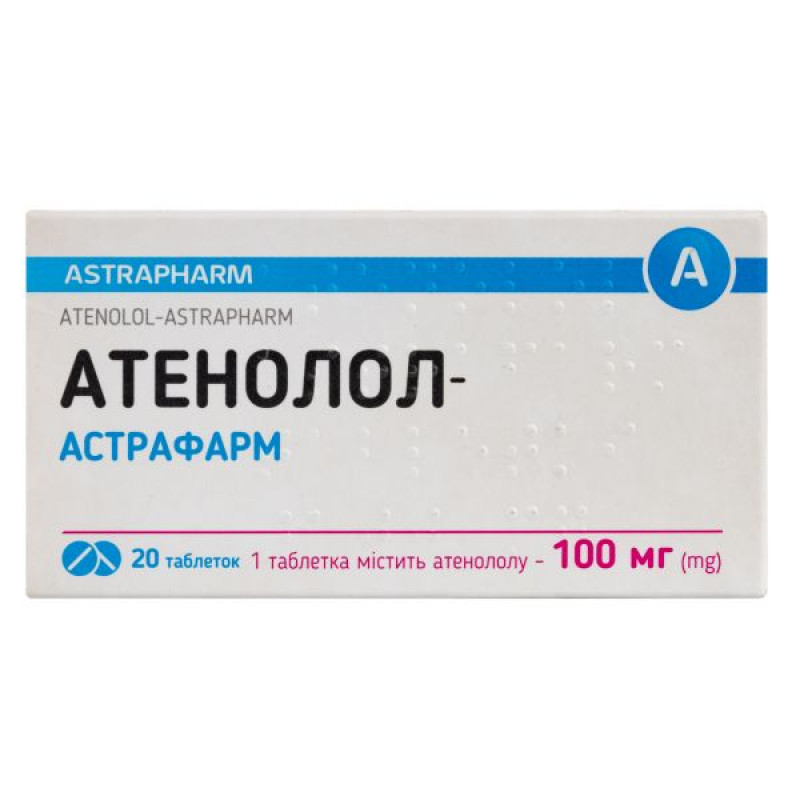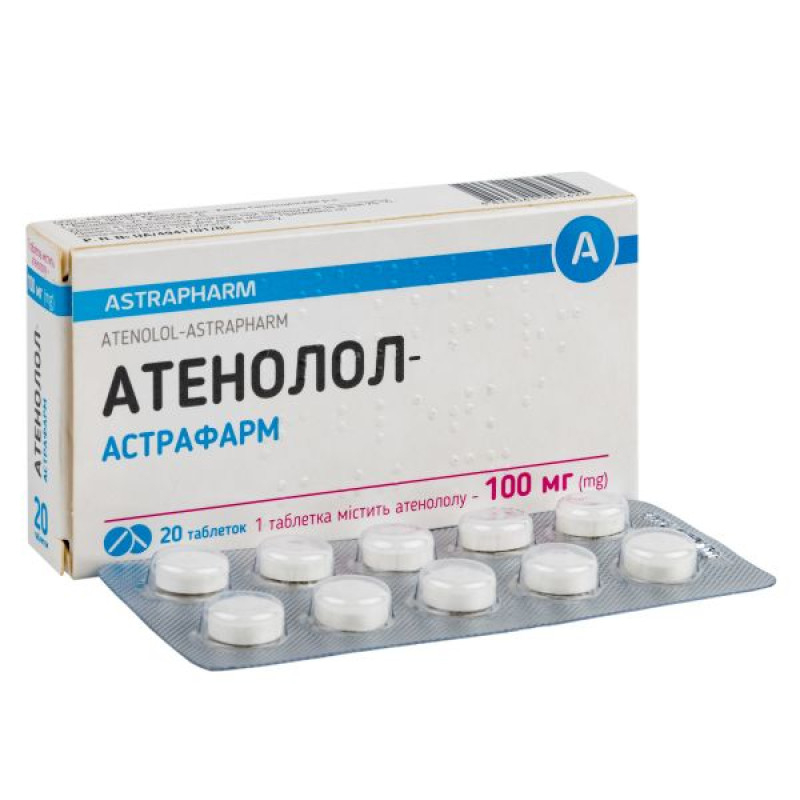Atenolol-Astrafarm tablets 100 mg No. 20

Instructions for Atenolol-Astrapharm tablets 100 mg No. 20
Composition
active ingredient: atenolol;
1 tablet contains atenolol 50 mg or 100 mg;
excipients:
for 50 mg tablets: lactose monohydrate; magnesium stearate; corn starch;
for 100 mg tablets: lactose monohydrate; magnesium stearate; potato starch.
Dosage form
Pills.
Main physicochemical properties: white or almost white tablets, round in shape with a biconvex surface and a score on one side.
Pharmacotherapeutic group
Selective β-adrenergic blockers. ATC code C07A B03.
Pharmacological properties
Pharmacodynamics.
Cardioselective β-adrenergic blocker. Has antianginal, antihypertensive and antiarrhythmic effects. Has no intrinsic sympathomimetic and membrane-stabilizing activity. Reduces sinus node automatism, slows atrioventricular conduction, reduces myocardial contractility and its oxygen demand. Has negative chrono-, dromo-, batmo- and isotropic effects.
Pharmacokinetics.
After oral administration, 50-60% of atenolol is absorbed from the gastrointestinal tract. The maximum concentration in blood plasma (2 μg/ml) is observed after 2-4 hours. The half-life is 6-7 hours. Less than 5% of atenolol binds to blood proteins. Atenolol is a hydrophilic drug, poorly penetrates the blood-brain and placental barriers and penetrates into breast milk. Atenolol is metabolized to a small extent (less than 10%) in the liver. Most of atenolol (85%) is excreted in the urine unchanged.
The half-life may be longer in patients with renal insufficiency. It is removed by hemodialysis.
Indication
Treatment of arterial hypertension.
Treatment and prevention of angina attacks (chronic stable and unstable angina, especially when combined with tachycardia and arterial hypertension).
Cardiac arrhythmias (arrhythmia, sinus tachycardia, prevention of supraventricular tachycardia, paroxysmal supraventricular tachycardia, atrial fibrillation and flutter; ventricular (ventricular arrhythmias), including those caused by increased physical activity, taking sympathomimetic drugs; prevention of ventricular tachycardia and ventricular fibrillation.
Myocardial infarction (treatment and prevention to reduce mortality and reduce the risk of recurrent infarction).
Contraindication
Hypersensitivity to atenolol or to other β-adrenergic agonists, or to any of the components of the drug;
acute heart failure;
cardiogenic shock;
atrioventricular block of the II and III degrees;
sick sinus syndrome;
sinoatrial block;
sinus bradycardia (heart rate less than 45 per minute);
arterial hypotension (systolic pressure less than 90 mm Hg);
bronchial asthma;
metabolic acidosis;
late stages of peripheral circulatory disorders;
simultaneous administration of MAO inhibitors (except MAO-B inhibitors);
untreated pheochromocytoma;
renal failure;
childhood.
Interaction with other medicinal products and other types of interactions
With simultaneous use of atenolol and:
The effect of oral antidiabetic agents, such as insulin, may be increased or prolonged. Symptoms of hypoglycemia (especially tachycardia and tremor) may be masked or disappear. Therefore, regular blood sugar monitoring is necessary;
tricyclic antidepressants, barbiturates, phenothiazides, nitroglycerin, diuretics, vasodilators and other antihypertensive agents (e.g. prazosin) may increase the hypotensive effect;
calcium channel blockers (such as nifedipine), in addition to increasing the hypotensive effect, heart failure may develop;
Calcium channel blockers with a negative isotropic effect (such as verapamil, diltiazem) may enhance their effect, especially in patients with impaired ventricular function and/or atrioventricular conduction, which increases the risk of developing arterial hypotension and bradycardia. If intravenous administration of verapamil is necessary, this should be done at least 48 hours after discontinuation of atenolol;
cardiac glycosides, reserpine, α-methyldopa, guanfacine and clonidine may cause a significant slowdown in heart rate;
indomethacin may reduce the antihypertensive effect of atenolol;
The antihypertensive effect of narcotics and antiseptics is enhanced. In this case, an additive, negative isotropic effect of both drugs is manifested;
peripheral muscle relaxants (e.g. suxamethonium, tubocurarine) may increase neuromuscular blockade, therefore, before surgery involving anesthesia, the anesthesiologist should be informed that the patient is taking Atenolol-Astrapharm;
Euphyllin and theophylline may inhibit the therapeutic effects;
lidocaine may reduce its excretion and increase the risk of lidocaine toxicity;
In patients taking Atenolol-Astrapharm and clonidine simultaneously, the latter can be discontinued only a few days after discontinuation of treatment with the drug.
Application features
Intravenous calcium channel blockers such as verapamil and diltiazem or other antiarrhythmics (e.g. disopyramide) should not be used during treatment with atenolol.
The exception is patients who are being treated in intensive care units.
In all of these cases, the doctor should carefully weigh the benefit/risk ratio when prescribing Atenolol-Astrapharm.
If patients have experienced thrombocytopenic or non-thrombocytopenic purpura while being treated with other β-blockers, the possibility of this side effect occurring during treatment with atenolol should be considered.
It should be remembered that during the administration of atenolol, manifestation of latent diabetes mellitus or worsening of the condition of patients with diabetes mellitus is extremely rare. Sometimes lipid metabolism disorders are observed: with a level of total cholesterol remaining normal, the level of high-density lipoproteins decreases and the level of triglycerides in the blood plasma increases.
Do not change the dosage or stop treatment with atenolol without consulting your doctor. Abrupt discontinuation of the drug may cause withdrawal syndrome. Therefore, discontinuation of the drug and dose reduction should be slow and gradual.
Atenolol-Astrapharm should be prescribed with extreme caution and only under strict medical supervision:
with first-degree atrioventricular block;
in diabetes mellitus with fluctuations in blood sugar levels (due to the possibility of severe hypoglycemic conditions);
in case of prolonged fasting and heavy physical exertion (severe hypoglycemic states may occur);
with pheochromocytoma (without α1-adrenoreceptors);
with impaired liver and/or kidney function (when prescribing atenolol to this category of patients, constant monitoring of the dynamics of the functional state of the liver and/or kidneys is required);
with existing psoriasis or psoriasis in personal or family history;
patients with peripheral circulatory disorders, including Raynaud's syndrome;
patients undergoing desensitization therapy or with a history of severe allergic reactions;
In thyrotoxicosis, atenolol may mask the clinical signs of hyperthyroidism.
β-blockers are not recommended for vasospastic angina (Prinzmetal's angina).
Atenolol-Astrapharm should be prescribed with caution to patients with myasthenia gravis.
If surgical interventions are necessary, it is recommended to discontinue Atenolol-Astrapharm therapy 24 hours before surgery or to select an anesthetic with minimal negative inotropic effect.
In thyrotoxicosis, atenolol may mask the symptoms of hypoglycemia, in particular tachycardia.
For elderly patients, it is recommended to start treatment with reduced doses (the dose can be increased under the control of blood pressure and heart rate). If such patients develop severe bradycardia, arterial hypotension, rhythm disturbances, conduction disturbances or other complications, the dose of atenolol should be reduced or discontinued.
The drug contains lactose, so it should not be prescribed to patients with rare hereditary forms of galactose intolerance, lactase deficiency or glucose-galactose malabsorption syndrome.
Use during pregnancy or breastfeeding
Atenolol crosses the placental barrier.
During pregnancy (especially in the first trimester), Atenolol-Astrapharm can be used only when the expected benefit to the mother outweighs the potential risk to the fetus, since there is still no sufficient experience of its use in pregnant women, especially in the early stages. If women have taken atenolol, then due to the possibility of bradycardia, hypoglycemia and respiratory depression in the child, treatment should be stopped at least 24-48 hours before delivery. If this is not possible, the baby should be closely monitored for 24-48 hours after delivery.
Atenolol passes into breast milk, so breastfeeding should be discontinued during treatment with the drug.
Ability to influence reaction speed when driving vehicles or other mechanisms
At the beginning of treatment, with increasing dosage and development of adverse reactions, the reaction speed may decrease, therefore, you should refrain from driving vehicles and working with precise mechanisms.
Method of administration and doses
The tablets are swallowed without chewing and washed down with a small amount of liquid, before meals, preferably at the same time.
The doctor sets the dosage of the drug and the duration of treatment individually depending on the therapeutic effect obtained.
Myocardial infarction: after internal administration, 50 mg orally is prescribed 12 hours after the injection and 100 mg after another 12 hours.
Arterial hypertension: treatment is usually started with 100 mg of Atenolol-Astrapharm once a day. Some patients require 50 mg per day. The effect is observed after 2 weeks. In case of ineffectiveness, atenolol is used together with diuretics.
Supraventricular (supraventricular) and ventricular (ventricular) arrhythmias: Atenolol-Astrapharm is prescribed 1-2 times a day at 50-100 mg.
The maximum daily dose is 200 mg.
In patients with significant renal impairment, the doses of Atenolol-Astrapharm depend on the level of creatinine clearance (CC): with CC 10-30 ml/min, the doses are reduced by 2 times (50 mg per day or every other day), and with CC less than 10 ml/min, the doses are reduced by 4 times compared to normal.
Patients on hemodialysis should use 50 mg of the drug after each dialysis.
This must be done in a hospital setting, as a noticeable drop in blood pressure may occur.
Children.
The drug is not used in children.
Overdose
Symptoms: the clinical picture depends on the degree of intoxication and is manifested mainly by disorders of the cardiovascular and central nervous systems.
Overdose can lead to arterial hypotension, bradycardia, heart failure and cardiogenic shock. In severe cases, respiratory failure, bronchospasm, vomiting, impaired consciousness are observed; extremely rarely - generalized convulsions.
Treatment: In case of overdose or in a condition where there is a threat of a decrease in heart rate and/or blood pressure, treatment with atenolol should be discontinued. In intensive care units, vital parameters should be carefully monitored and adjusted if necessary.
If necessary, prescribe:
atropine (0.5-2 mg intravenously as a bolus);
glucagon: initial dose 1-10 mg intravenously (jet), then 2-2.5 mg/h as a continuous infusion;
sympathomimetics depending on body weight and effect (dopamine, dobutamine, isoprenaline, oxyprenaline or adrenaline).
If bradycardia is refractory to therapy, temporary pacing is possible.
For bronchospasm, β2-sympathomimetics are prescribed in the form of an aerosol (if the effect is insufficient, also intravenously) or aminophylline intravenously.
For generalized seizures, slow intravenous administration of diazepam is prescribed.
Removed by hemodialysis.
Side effects
From the cardiovascular system: bradycardia, arterial hypotension, atrioventricular conduction disorders (up to cardiac arrest) and symptoms of heart failure, feeling of coldness and paresthesia in the extremities. In some cases, in patients with angina pectoris, an increase in attacks cannot be ruled out.
Nervous system: dizziness, feeling of increased fatigue, headache, sleep disturbances, nightmares, depressive disorders, hallucinations, psychosis, insomnia or drowsiness, confusion.
From the digestive tract: dyspepsia, diarrhea, nausea, constipation, hepatotoxicity, dry mouth, abnormal transaminase levels, intrahepatic cholestasis.
On the part of the endocrine system: the development of a hypoglycemic state is possible, especially in patients with diabetes mellitus on the background of hypoglycemic therapy.
On the part of the immune system: itching, redness of the skin, exanthema, photosensitivity, hypersensitivity reactions (angioedema), skin rashes (exacerbation of psoriasis), urticarial rashes, increased levels of antinuclear antibodies.
On the part of the urinary system: in isolated cases, cases of impaired libido and potency, gynecomastia, impotence, difficulty urinating have been observed.
On the part of the respiratory system: in patients with a predisposition to possible manifestations of bronchial obstruction; bronchospasm.
From the blood system: purpura, thrombocytopenia.
Others: conjunctivitis or decreased secretion of the lacrimal glands, increased sweating, visual impairment, muscle weakness, feeling of dryness in the eyes, alopecia, psoriasis-like skin reactions.
Expiration date
3 years.
Storage conditions
Store in the original packaging at a temperature not exceeding 25 °C.
Keep out of reach of children.
Packaging
10 tablets in a blister; 2, 6, 9 or 10 blisters in a box.
Leave category.
According to the recipe.
Vacation category
According to the recipe.
Producer
ASTRAPHARM LLC, Ukraine.
Address
08132, Kyiv region, Kyiv-Svyatoshynskyi district, Vyshneve town, Kyivska st., 6.
There are no reviews for this product.
There are no reviews for this product, be the first to leave your review.
No questions about this product, be the first and ask your question.








